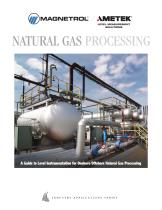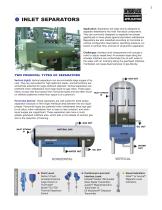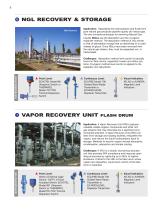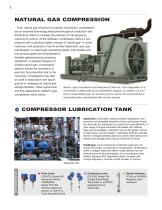 Website:
Magnetrol - AMETEK
Website:
Magnetrol - AMETEK
Group: AMETEK
Catalog excerpts

A Guide to Level Instrumentation for Onshore/Offshore Natural Gas Processing
Open the catalog to page 1
Level & Flow Applications for GAS Stream Level Applications Liquid Processing Amine Separation Level Applications: APPLICATION Natural Gas processing is typically found in crude oil drilling and processing operations. For information on level applications for crude oil processing, see our Crude Oil Processing brochure. Level and flow controls in these applications are crucial for both process control and safety shutdown systems. 7. Vapor Recovery Unit WATER Stream Level Applications Sulfur Treatment Collection Tanks Primary Water Treatment 10. Compressor Lubrication 8 11. Compressor...
Open the catalog to page 2
INLET SEPARATORS Application: Separators are large drums designed to separate wellstreams into their individual components. They are commonly designed to separate two-phase (gas/liquid) or three-phase (gas/crude/water) wellstreams. Separators are also classified according to horizontal or vertical configuration (see below), operating pressure, turbulent or laminar flow, and test or production separation. Challenges: Interface level measurement will actuate a valve to adjust vessel level. An emulsion layer along the oil/water interface can contaminate the oil with water or the water with...
Open the catalog to page 3
CHEMICAL INJECTION Chemical Injection Skid Application: Chemical agents employed in natural gas processing include drilling fluid additives, methanol injection for freeze protection, glycol injection for hydrate inhibition, produced water treatment chemicals, foam and corrosion inhibitors, de-emulsifiers, desalting chemicals and drag reduction agents. Chemicals are frequently administered by way of chemical injection skids. Challenges: Level monitoring controls chemical inventory and determines when the tanks require filling. The careful selection and application of level controls to...
Open the catalog to page 4
SULFUR RECOVERY Sulfur Recovery Unit Application: A sulfur recovery unit converts the hydrogen sulfide in the acid gas into elemental sulfur. Of the processes available for these conversions, the Claus process is by far the most well-known for recovering elemental sulfur, whereas the conventional Contact Process and the WSA Process are the most used technologies for recovering sulfuric acid. The residual gas from the Claus process is commonly called tail gas. Tail gas is subsequently processed in a gas treating unit. Challenges: The sulfur condenser vessel is equipped with a disengagement...
Open the catalog to page 5
NGL RECOVERY & STORAGE NGL Recovery Application: Separating the hydrocarbons and fluids from pure natural gas produces pipeline quality dry natural gas. The two principle techniques for removing Natural Gas Liquids (NGLs) are the absorption and the cryogenic expander method. The absorption method is very similar to that of dehydration except that an absorbing oil is used instead of glycol. Once NGLs have been removed from the natural gas stream, they must be separated out, or fractionated. Challenges: Absorption method level control is typically found on flash drums, separation towers and...
Open the catalog to page 6
STORAGE TANKS Storage Tanks Application: Natural gas, oil, liquid fuel, treatment chemicals, extracted condensate from separators and water are stored in gas fields. Unlike midstream tank farms at terminals and refineries, field storage consists of smaller vessels. Diesel generator fuel, potable water, and fire water are also stored in tanks. Challenges: Tank level monitoring can be provided with overflow control and alarm systems or shutdown pumps when level falls below the specified low level. Interface controls will sense the beginning of an oil/water interface during tank dewatering and...
Open the catalog to page 7
NATURAL GAS COMPRESSION From natural gas extraction to pipeline tranmission, compressors are an essential technology employed throughout production and distribution chains to increase the pressure of natural gas by reducing its volume. At the wellhead, compression allows a lowpressure well to produce higher volumes of natural gas—in some instances, well production may be entirely dependent upon gas compression. In natural gas processing plants, intermediate and end product gases are compressed to facilitate gathering and processing operations. In pipeline transport of purified natural gas,...
Open the catalog to page 8
Application: Natural gas can travel through thousands of miles of pipeline. Compressors placed at key intervals keep the natural gas moving evenly and reliably. Atypical compressor station consists of an inlet scrubber to collect liquids and slugs that may have formed in the gas pipeline. The scrubber consists of a primary section where liquids and solid parts are separated from the gas stream and a secondary section where oil mist is removed. Challenges: The liquids collected from the suction scrubber are typically routed by way of scrubber level control valves to a low pressure (LP) tank....
Open the catalog to page 9
FLARE KNOCK-OUT DRUM Application: Liquid in the vent stream can extinguish the flame or cause irregular combustion and smoking. In addition, flaring liquids can generate a spray of burning chemicals—a “rain of fire”—that create a severe safety hazard. A knockout drum collects these liquids prior to entering the flare system. A level gauge and drain connections are built into the knockout drum. Challenges: When a large liquid storage vessel is required and the vapor flow is high, a horizontal drum is usually more economical. Vertical separators are used when there is small liquid load,...
Open the catalog to page 10
Good Practices for Leading Level and Flow Instrumentation I Guided Wave Radar Probe Buildup Natural gas, condensate and crude processing applications have some special requirements that are not evident from Instrument Data Sheets. Experience has lead to some simple but effective recommendations to address these field issues not contained in Data Sheets. Natural gas, condensate and crude processing applications can experience paraffin, asphaltenes, grit and grime buildup. The degree of buildup varies widely. Even in applications where it isn’t prevalent, over time it can happen during cold...
Open the catalog to page 11All Magnetrol - AMETEK catalogs and technical brochures
-
Interface In The Field
14 Pages
-
Emulsion In The Field
9 Pages
-
PRODUCT LINE CATALOGUE
106 Pages
-
Aurora® Magnetic Level Indicator
28 Pages
-
Atlas™ Magnetic Level Indicator
24 Pages
-
STEAM DRUM LEVEL MATTERS
1 Pages
-
INTERFACE IN THE FIELD
1 Pages
-
Echotel® 355
4 Pages
-
Echotel® 335
4 Pages
-
Power Generation
16 Pages
-
Petroleum Refining
16 Pages
-
Seal Pots
4 Pages
-
Mass Flow Measurement
12 Pages
-
Interface Level Measurement
8 Pages
-
Heat Rate Awareness
8 Pages
-
Ethylene Applications
8 Pages
-
Thermatel® TD1/TD2
16 Pages
-
Kotron® 082
4 Pages
-
Enhanced Jupiter®
16 Pages
-
GEMINI™
32 Pages
-
Aurora®
32 Pages
-
Atlas™
24 Pages
-
Horizon TM Model 704
8 Pages
-
Eclipse® Enhanced 705 Hygienic
12 Pages
-
Eclipse® Enhanced 705
8 Pages
-
Pneumatic Tuffy®
12 Pages
-
Models T5x & T6x
8 Pages
-
Models T20/T21
12 Pages
-
Series B73 and Series 75
12 Pages
-
Series 3
24 Pages
-
Model J52
2 Pages
-
Model B40
4 Pages
-
TUFFY® II
12 Pages
-
Digital E3 Modulevel®
12 Pages
-
Floating Roof Detection
16 Pages
-
APM Pneumatic Modulevel®
12 Pages
-
Flue Gas Desulferization
8 Pages
-
Energy Management
4 Pages
-
API 2350 Overfill Prevention
8 Pages
-
PULSAR ® R96
1 Pages
-
Water & Wastewater
12 Pages
-
Displacer Switches
20 Pages
-
Displacer Transmitters
4 Pages
-
Guided Wave Radar
12 Pages
-
Magnetic Level Indicators
12 Pages
-
Magnetostrictive
16 Pages
-
Pulse Burst Radar
8 Pages
-
Thermal Dispersion
12 Pages
-
Ultrasonic Contact
4 Pages
-
Vibrating Rod Switches
4 Pages
-
R Series High Temp Switch
12 Pages
-
Series K Pneumatic Switch
8 Pages
-
J Series Pneumatic Switch
8 Pages
-
Liquid Displacer Level Switches
16 Pages
-
Crude Oil Processing
8 Pages
-
Product Line Quick Reference
8 Pages





























































































